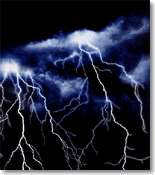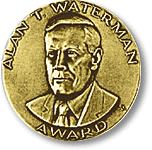 |
 Celebrating National Science & Technology Week Celebrating National Science & Technology Week
|
 |

National Science
& Technology Week Seeks to Raise Science Literacy
While only
one quarter of Americans understand science well enough
to make informed judgments from or about science,
the National Science Foundation's National Science
& Technology Week '99 (NSTW '99) is helping to improve
the nation's level of science understanding. Celebrated
the week of April 25 to May 1, NSTW brings science
and engineering technology directly to millions of
Americans through exhibits, lectures, events and hands-on
activities designed to make science, engineering and
technology fun and easier to understand. The week
represents the largest concentration of science education
events and activities held in the United States.
More...
|
 |

First
Estimates Developed of Lightning-Associated "Sprites"
For the first
time, scientists have developed a reliable estimate
of the number of "sprites" spawned by a single thunderstorm.
Sprites, the luminous red glows that are the high
altitude companions of some lightning strikes, are
the focus of a new study by researchers Steven Reising
of the University of Massachusetts, and Umran Inan
and Timothy Bell of Stanford University in California.
The team's findings appear in the April 1 issue of
Geophysical Research Letters (GRL), published by the
American Geophysical Union. The work was funded by
the National Science Foundation (NSF), the U.S. Air
Force, and NASA. "Sprites are spectacular luminous
evidence of electrodynamic coupling between the neutral
atmosphere in which weather processes occur and the
higher altitude (60-90 km) ionized regions of the
earth's atmosphere known as the mesosphere and the
lower ionosphere," explains Sunanda Basu, director
of NSF's aeronomy program, which funded the research.
"The importance of the new finding is that the radio
signals produced by lightning discharges that lead
to sprites are distinctly different from those due
to other lightning discharges."
More...
|
 |

Stanford
Chemical Engineer Chaitan Khosla Receives Alan T.
Waterman Award from NSF
A 34-year-old
Stanford University professor of chemical engineering
and chemistry whose work is leading to the discovery
of new drugs to fight infections and diseases has
received NSF's most prestigious prize for young researchers.
Chaitan S. Khosla will be honored with the 1999 Alan
T. Waterman Award at a National Science Board awards
ceremony May 5 in Washington, D.C. Khosla's work in
elucidating the genes involved in the microbial production
of polyketides, and methods for modifying these genes,
"has captured the attention of the entire pharmaceutical
industry as an exciting new approach for the production
of new antimicrobial agents from engineered organisms,"
said 1988 Waterman Award winner and University of
California-Berkeley professor of chemistry Peter G.
Schultz.
More...
|
 |

NSF
to Provide $21 Million for Computer Science, Engineering
and Math Scholarships
The National
Science Board has approved plans by the National Science
Foundation (NSF) to provide some $21 million to fund
8,000 one-year scholarships of up to $2,500 each to
low income students who pursue degrees in computer
science, engineering or mathematics. These Computer
Science, Engineering, and Mathematics Scholarships
(CSEMS) are authorized by the American Competitiveness
and Workforce Improvement Act of 1998. According to
Luther S. Williams, NSF's director of education and
human resources, 100 institutions will receive the
two-year scholarship fund grants in the first year
of the program. "These scholarships are not expected
to be a 'magic bullet,'" Williams said. "They are
but one component of what necessarily must be a multi-pronged
approach to ameliorating the nation's current need
for people trained in the sciences, math and high-technology,"
he said.
More...
|
 |
|
 Image courtesy of Dale Chayes of the Lamont-Doherty
Earth Observatory at Columbia University.
Image courtesy of Dale Chayes of the Lamont-Doherty
Earth Observatory at Columbia University.
|
Nuclear
Submarine Puts to Sea to Serve Science
Researchers
supported by the National Science Foundation (NSF)
are sailing aboard a U.S. Navy nuclear submarine in
April to map the oceanic ridges and basins beneath
the Arctic ice cap and study ocean currents that may
have an effect on global climate. NSF is mounting
Scientific Ice Expedition (SCICEX) '99 in cooperation
with the U.S. Navy and the Office of Naval Research.
The exercise is the fifth in a series of annual SCICEX
missions, all of which have employed some of the world's
stealthiest and most maneuverable warships. SCICEX
'99 will be conducted aboard USS Hawkbill (SSN 666),
which is able to travel almost at will under the ice,
making it a unique platform for a sophisticated sonar
system dubbed the Seafloor Characterization and Mapping
Pods (SCAMP).
More...
|
 |
 
|

